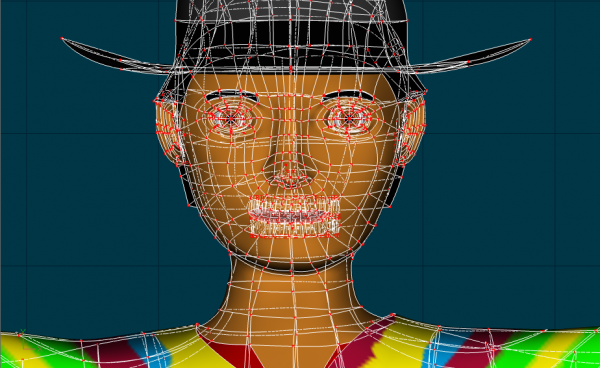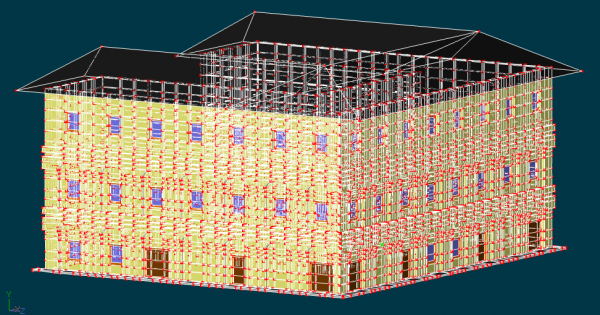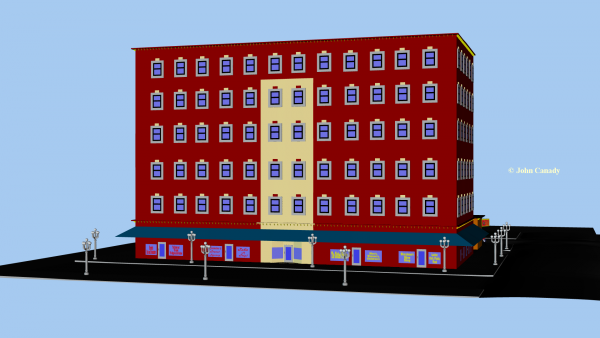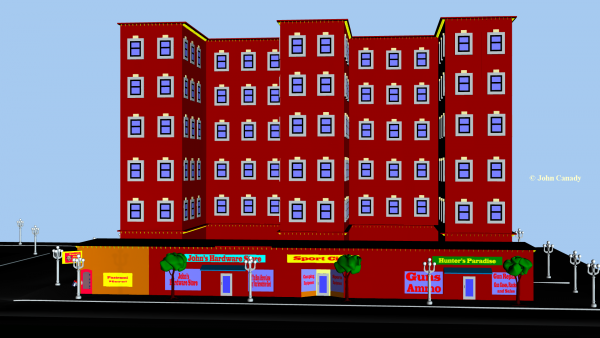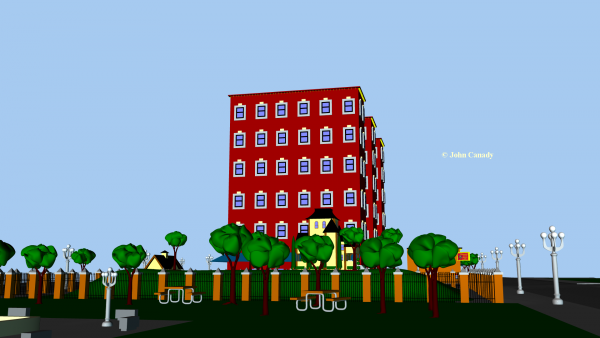-
Posts
99 -
Joined
-
Last visited
-
Days Won
5
Content Type
Profiles
Forums
Events
Everything posted by Pitcher
-
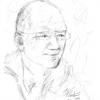
Shaded and wire frame is not looking the way it did
Pitcher replied to Pitcher's topic in Open Forum
I continue to have difficulty. I have returned the program to default values. I have done shift-6. Below is a picture of how a face looks in shaded and wireframe: (Thanks for your help!) -
This looks like great advice! Thanks for the detail!
-

Shaded and wire frame is not looking the way it did
Pitcher replied to Pitcher's topic in Open Forum
Thanks for the suggestions. I have rebooted several times. My program is displaying this way on every model--not just this one. I will try shift-F6. Sorry I did not check back for a while. My regular e-mail used to leave a message whenever anyone replied, but this time it did not. I didn't know that anyone had noticed this, so I did not check back as soon as I should have. -
I am curious why things in front of a rotoscope look like they move forward when nothing changes but the camera's focal length. The 3-D models in front of a rotoscope also seem to move when the camera changes angle of rotation, and I understand that to some extent. Is there an easy fix for this apparent movement? Here is an animated gif I made recently of objects in front of a rotoscope of a Christmas tree: http://giphy.com/gifs/l0MYJd44wSpygYJ8Y
-
I am curious why things in front of a rotoscope look like they move forward when nothing changes but the camera's focal length. The 3-D models in front of a rotoscope also seem to move when the camera changes angle of rotation, and I understand that to some extent. Is there an easy fix for this apparent movement? Here is an animated gif I made recently of objects in front of a rotoscope of a Christmas tree:
-
For whatever reason--Maybe I pressed a button without realizing it or Maybe Windows 10 is doing something--shaded and wire frame does not look the same. Instead of showing the CPs and splines on the surface, it is showing them throughout the figure, even from the other side of the figure. The view just adds a semitransparent color to regular wire frame. What do I press to get just cps and wire-frame back on the outer surface? Thanks.
-
I was unfamiliar with how to make a displacement decal or bump map, but I found an explanation for using a bump map or displacement map on pp. 432-448 of Animation:Master, A Complete Guide by David Rogers, 2007. If anyone else is interested who isn't familiar with these, Rogers book might help.
-
Sorry! I just tried normal rendering, and everything is fine. I wish this would be consistent, instead of working almost all the time and not working sporadically. It always throws me.
-
I have applied decals many times. Now I have one that applies fine when I have the patches that it touches selected and the others hidden. When I bring back the other patches, however, the decal becomes spotty on one of the patches where it was fine before. I have tried to apply the decal with the entire figure showing, but when I do that, the patch that rejects the decal will not cover. I have found normals and flipped normals, and everywhere I could find anything about normals I tried to do something. Please tell me what is going on and why the decal will not apply evenly and continue to stick. Thanks.
-
Thanks very much for the help. The example is especially nice. Sometimes I get so busy doing some of this stuff the only way I know how that I don't take time to learn new things. I'm at a stopping place now and will be looking more closely at the examples and the tutorials.
-
I need to learn about that.
-
I wasn't talking about a lot of movement. Just a tiny bit can make the parts of a building show a little space or hands that should be joined show a little space. You can also see a little movement when you are straightening lines on a building, and the points that should be lined up (meaning that you lined them up manually many times), but then after several more sessions where the program has opened and closed, the points are no longer lined up exactly. Anyway, I am prepared to live with all of that. It doesn't seem to be a major difficulty compared to working with huge files. I have not finished with my town scene yet. I will probably keep tweaking the buildings I have, and I will add many more. I have now broken the huge file building down into many parts and reassembled the parts in a chor file. I am posting several pictures of the building below after I have assembled it in a chor file. Robcat had mentioned wanting to see it before making any further suggestions. Maybe this will help clarify what I have been describing. The little strip center building behind the multistory building was never part of the file I have been discussing, nor was the house or its grounds.
-
Thanks. That will help me master the problem.
-
I thought slippage might get some attention. When I was having characters square dance, they would be lined up properly holding hooves, and then I would come back to them, and there was visible space between them. Their hooves did not meet the way they did before. It also seemed at times as if the buidings would shift slightly. That's what I meant. Maybe it was my imagination, but it happened frequently. I notice that when others plan dance scenes, the dancers usually dance as individuals rather than holding hands. I thought maybe other people had slippage also and had planned their scenes accordingly. I also read about procedures for having a character pickup a glass and take a drink and then put the glass down. It seems that special procedures are necessary to keep the glass in the character's hand. I wondered about keeping the building together. Is something special required? I seem to remember in the dancing daisy lesson, it is necessary to link the leaves to the stem so that they don't separate during movement. There might also have been a statement about some slight movement just due to opening and closing the program over and over again, as if the picture suffers some bit of degeneration. That's another reason why I was afraid to put buildings in pieces unless they were designed more or less like building blocks that would be easy to shove together.
-
I have been removing every extra patch I can find. I have been breaking up the model into pieces that could be put together easily. I have been eliminating redundant pieces. As I have spent time doing this, I have adjusted to the new world view. I resisted at first, because I thought of modular construction as discreet pieces put together like building blocks, and at some point, I experienced some slippage in the location of parts I added in a chor file. I did not want to put parts in a chor file that had to fit together without much variation. I now see the many advantages of dividing even a single unified model into components. For example, I have the six story office/apartment/hotel building with decorative flourishes and rows of windows. I have, from the beginning, planned to use it in several heights and colors. It will be much easier to make the changes if I break the building up into "basic structure," "window row 1" (with windows trimmed in one color), "window row 2" (with windows trimmed in a different color, "roof braces" (with a row of decorative braces placed around the roof), and "doors" (with doors located in relation to the basic structure). I can modify the parts as needed more easily and add additional instances of the parts more easily as I expand the building in the chor file. I also think I can find a way to keep the parts in place in relation to each other. One other concern I have that makes me a little resistant to modification is that I never want the program to dictate the final result. I know in my head what I want my scene to look like in the end. Other people might not think the idea is very good, but I do. I do not want to change my idea of the outcome, because the program has some limitation. One of the things that worried me was the observation that there was detail in the Tin Woodman that was unnecessary and unseen by the audience. To me, the great strength of the Tin Woodman was the detail. I loved seeing what the program would do. I don't ever want to settle for less than my original idea because I think the audience would not appreciate the difference. That's one reason why I end up with a model that has almost 300,000 patches before I mention the problems I am having. I am willing to push this program to hell and back to get what I want as a final look. I am retired and have time, and I am willing to spend a little extra time. Finally, however, I thought that this just seems too weird, and there might be a fix. Thank you, Everyone, for your great advice and efforts to provide examples and so forth. You have convinced me.
-
I will go through your tutorials as soon as possible. I also will start either breaking up the model or removing patches where possible. I will let you know how that goes. Thanks for your help.
-
Thanks, your information helps. Sometimes, if I can slightly understand what the program is really doing, it helps me avoid some problems. I have been thinking of ways I can use the decal and still get down the number of patches without losing the 3-D quality. I never have really understood, however, how to import only one copy of the model and then replicate the rest with written statements. Where do I write and what do I write? I'm nearly through with this model, but all of this will help me to avoid the problem in the future.
-
It finally stopped saving and I right clicked on Info. The information was as follows: Total Patches = 282322 5 Point Patches = 3104 Total Hairs = 0 Total Bones = 0 Total Nulls = 0
-
There are several parts of the answers above that intrigue me. First, you mentioned putting one instance of a model in the file and replicating it by reference. I would like to know exactly how to do that. (The windows were all the same generally except for a color difference on a few. The 800 or so roof braces were all the same. The trees in the forest were all the same.) When I talked about rotating each 30 degrees, I really meant each tree. Your idea of an equation that would rotate them randomly would be the goal. I would need to know where to write such an equation. I am interested in know how to replicate by reference and then position the referenced models. For example, I have the 800 roof braces spaced around the perimeter of the building. How could I position the referenced braces? As far as using decals for the windows, I thought of that earlier, but I would lose a little texture. I already plan to use quite a few decals on the bottom story on shop windows. I did not want the entire building to look flat. I still might end up making the windows decals, however, and I am prepared to cut back on my expectations if necessary. Another idea I liked is that we can model in a chor file. I never have difficulty with size in a chor file. The only place I've had difficulty with size is in a model file. Most of the time I could avoid that by breaking up the model, and I have done that when convenient. I would like to know how to build and save models in a chor file. I am still interested in knowing what the program really does when it saves in a model file. Is the model file really a large data base with each control point and spline referenced in three dimensional space with patches calculated and colors entered? Is the computer running through the database comparing what we have shown on the screen with what is already there? Do certain types of changes make the computer work harder than other types of changes? I'm guessing from what you said earlier that the rendering program references the saved database and then identifies changes that have been made from the saved data. That's why saving before rendering is so important. The rendering program has more difficulty, the more changes have been made since the data was last saved. I really appreciate the effort everyone has gone to in answering my questions. Rodney, your city of skyscrapers is terrific. It's not really what I was going for, but I like it. My problem this time is with the one building that uses so many patches. My cityscape will be various kinds of buildings as seen from ground level. For example, there will be a block on one story shops, a Victorian home, a park with a fountain, a six story office, apartment, or hotel building with shops on the bottom floor, an office skyscraper, a parking structure, a museum, a library. Some of the buildings will probaby be modified and replicated in different heights, numbers of stories, and/or colors. There will be pedestrians, street lights, traffic signs, and street traffic.There may be little efforts to add greenery to the city setting. I am looking for the whole effect to be diverse complexity. This is not a look over there and see the huge city kind of cityscape. I want it to look like a place where people live and work and is also an area in transition from what once was large houses to now museum district with large buildings on the edge. The Victorian house will someday soon be torn down to make way for some larger more modern building. Some of the more modern buildings will be 40 or 50 years old and some will be much newer, taller, and more modern. I only tell you all of this to let you know the exact kind of problem I have. I have several blocks created in a model with streets, curbs, sidewalks, etc. and now I am designing buildings to set into the empty spaces. Thanks, Robcat. I will be looking at the information you referenced.
-
This is fabulous! This is just the information I needed. I will review this and use these tips. As I mentioned, this has been a continuous problem for me for a long time. I just got back from a birthday lunch where I ate far too much. I'm going to go take a nap and get back up and read your suggestions again and make them part of my standard practice. I'm not sure if you mentioned it, but is there a way to incorporate something like a 30 degree turn on the y-axis in the procedure for referencing the same model as it is used over an over again? I was just thinking about the forest I did in another model a year or two ago.
-
Really, I am talking about saving the model when I say it takes 10 to 14 hours. I am not talking about saving the project file. When I say I am rendering, I'm talking about a final render of four frames using a model file. The first frame sometimes goes crazy and twirls indefinitely. If the first one goes OK, the rest follow within seconds. I just make four frames for no particular reason. They are all the same. This is just a model file. I'm not sure how to get back to the little window that gives statistics on my model. The only time I saw it come up, it came spontaneously on its own. I just read the statistics at the time, closed it out, and continued working. That was about 8 or 9 days ago. This model has been in development for about 3 or 4 weeks. I do things in pieces, too, sometimes, but I did not see how I could reasonably divide this up. Actually, this building will be part of a cityscape. It will be one building among many in a chor. When I described the building before, I forgot to describe one of those additional details I alluded to earlier. I have about 800 or more decorative roof braces that are just under the eves of the roof on two levels of the building. That probably elevates the patch count considerably. After I added those, the "long save" started. The 240 windows just made matters worse. The basic building is no big deal at all. I'm in the middle of a long save right now with the twirling going. I cannot use the program when it twirls. When it finishes, I will look for the window with the statistics. Do you have any idea where to look? Also, one more thing I should mention. When the program twirls, I normally don't use the computer for anything else. I work on an older one. Sometimes, I do a few things on the main computer, but that's when I'm desperate. Sometimes, it messes up the save, and sometimes it doesn't.
-
Yes. I appreciate the additional information on how to partial render to get a look. That will probably help a lot. I agree also that saving should be a very short process, but this happens every time I get one of these huge models pretty far along. In this case, it started "the long save" about 1/4 of the way through. One time, a tiny window popped up and said I had something like 140,000 patches in my model. It was as if the program was protesting, because after that, the program became more and more finicky. I got rid of that window and continued. Now, I estimate that it's at about 300,000 patches. The model is a six story office building with 240 windows, 14 doors, and quite a few other details. I'm not sure what the saving process in this model is actually doing. I usually save about every 10 minutes until the "long save" process starts. Do you have any ideas why saving is taking so long?
-
Thanks for the advice, Fuchur and Rodney! I like to save often, but when I get in the final stages of building a model and it is taking half a day to save, I like to get a little work done between saves. I'll know for sure that I want to save before rendering. I had hoped to get a picture of what it looked like before turning it loose, but I'll know better next time.
-
I am running Version 18n 64 bit on a computer with 8GB of RAM and an i7 64 bit processor. Sometimes, it takes 10 to 14 hours to save my work. I work in wireframe and sometimes stop and render along the way so that I can see what the patches look like. I am wondering if there is a way to shorten the saving time, or is there a way to know when rendering time for a frame is going to exceed 7 minutes or so, before I press the render button. What happens when I render sometimes is that the computer buffers (twirls) and twirls indefinitely. I try to abort, and the rendering program seems to abort but twirling continues, and I cannot get back to where I can start the 10 to 14 hour save. Usually when this happens, I have to kill the program and restart and lose all my work. Is there a happy solution to all of this?
-
Thanks, Rodney! The program, as good as it is (and that's very good!), is quite comprehensive and can be very difficult to learn. As you know, before I found the Forum, I spent a little more than two years trying to learn the program on my own with the help of a couple of books. It was extremely frustrating, and unfortunately, I wrote quite a few very ugly emails to the tech support staff as I tried to get help there. Now, when I recommend the program to others, I always emphasize the importance of going to the Forum where they can get help. Without the Forum, the fun in animation is much harder to find. (One of the reasons I try to give full expression to my happiness and gratitude for the help I get in the Forum is to makeup for being so horrible before. If you know the tech support people, tell them I apologize. I feel a little like Rosanne Rosannadanna when she repeatedly threw a fit and then said, "Never mind!")
- 13 replies
-
- transparency
- font wizard
-
(and 1 more)
Tagged with:









